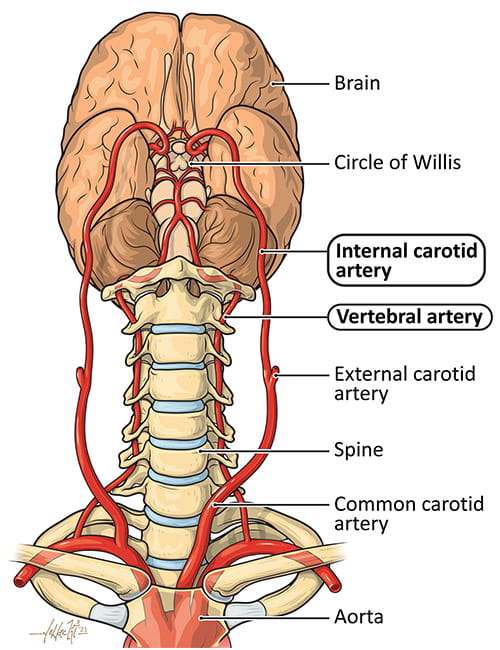
Cervical Artery Dissection
The leading cardiovascular specialists at University Hospitals Harrington Heart & Vascular Institute and neurology experts at University Hospitals Neurological Institute are dedicated to providing the very best treatment for serious vascular conditions such as cervical artery dissection, or CeAD. CeAD is a condition in which one or more of the large blood vessels (arteries) in the neck develops a tear. This condition is one of the most common causes of stroke in people under 50.
Your health is important. Make an appointment today.
Offering in-person, video and telephone visits. Call 216-770-5406 today to see which option is right for you.
What Is Cervical Artery Dissection?

Cervical arterial dissection is the abnormal and usually abrupt formation of a tear along the inner wall of any of the four main arteries that supply oxygen-rich blood to the brain (the two carotid arteries and two vertebral arteries). The carotid arteries run along each side of the neck; the vertebral arteries are located in the back of the neck near the spine.
As the arterial tear enlarges, blood leaks in and collects between the layers of the arterial wall where a blood clot can form, restricting the flow of blood through the artery. If the clot grows large enough to obstruct blood flow completely, a stroke will occur. Also, a stroke can happen if pieces of the clot break off and travel up the artery and into the brain. When cervical arterial dissection occurs for any reason other than trauma to the head or neck, the condition is referred to as “spontaneous.”
What Causes Cervical Artery Dissection?
The two main causes of cervical artery dissection are:
- Injury or strain to the neck or head
- An underlying health condition that weakens the cervical arteries
- Injury or Strain
-
Cervical artery dissection can occur as a result of a blunt trauma injury to the neck or head and even a sudden movement of the neck. Specific causes include:
- High-impact injury sustained in a car crash
- minor neck injury sustained during sports or exercise
- Neck strain from extreme positioning, for example, painting a ceiling or a similar activity
- Fits of violent coughing or vomiting
- Health Conditions that Can Weaken Blood Vessels
-
The following underlying medical conditions put individuals at risk for cervical artery dissection:
- Marfan syndrome, Loeys-Dietz syndrome, vascular Ehlers-Danlos syndrome and other inherited vascular conditions that predispose to dissection
- Fibromuscular dysplasia
- Atherosclerosis (accumulation of fatty plaque in artery walls)
Other risk factors for cervical artery dissection include high blood pressure and smoking.
What Are Cervical Artery Dissection Symptoms?
Sometimes a stroke is the first sign of cervical artery dissection, in which case emergency treatment is required. Symptoms of cervical artery dissection can vary from person to person. They depend on the extent to which the artery is affected and whether or not a stroke has occurred. Also, the set of common symptoms of carotid artery dissection differs from that of vertebral artery dissection. Stroke can occur hours, days or even a week after these symptoms begin.
- Carotid Artery Dissection Symptoms
-
Common symptoms of carotid artery dissection include:
- Bad headache
- Pain or tenderness on one side of the neck
- Facial or ear pain
- Pulsatile tinnitus (a rhythmic noise in the ears that often occurs in time with your heartbeat)
- Paralysis or partial paralysis of one side of the body
- Sight problems, including complete but temporary loss of sight
- Migraine symptoms, including seeing shimmering lights
- Drooping eyelid often with asymmetry of the pupils of the eyes
- Vertebral Artery Dissection Symptoms
-
Vertebral artery dissection symptoms are often similar to those of carotid artery dissection but may also include:
- vertigo (a sensation of moving or spinning when you are not moving)
- trouble with balance
- numbness of the face
- hoarseness of voice
- difficulty speaking or swallowing
- not sensing pain or hot/cold temperatures on the body, arms and legs
- loss of taste
- hiccups
- double vision
- hearing loss on one side
How is Cervical Artery Dissection Diagnosed?
When you visit a doctor's office or an emergency room with any of the symptoms described in the previous section, the provider will ask you about your symptoms and your health history. If a doctor then suspects cervical artery dissection, he or she will order one or more of the following diagnostic imaging tests:
- MRA (magnetic resonance angiogram) scan or CTA (computed tomographic angiogram) scan: Non-invasive tests that capture detailed images of the arteries in the head and neck
- Angiogram: Utilizes x-ray imaging to take pictures of blood vessels. At the beginning of the test, a contrast dye is injected into the arteries to make them visible in x-ray images. Angiograms are often given to patients with severe symptoms, such as symptoms of stroke, and if an intervention is needed.
- Doppler ultrasound: Uses sound waves to produce an image of the affected artery or arteries. The ability of Doppler ultrasound to diagnose cervical artery dissection is limited compared to MRA or CTA.
How is Cervical Artery Dissection Treated?
If a cervical artery dissection is discovered after a stroke has occurred, treating the stroke to minimize lasting effects is the most important treatment goal. Treatment of cervical artery dissection varies from case to case and from individual to individual and depends on:
- If the patient has experienced trauma
- The physical location of the dissection and how it occurred
- The size of the arterial tear and severity of the arterial narrowing
- Other injuries or medical conditions the patient may have
- How quicky the patient is able to obtain treatment
- If the patient has an underlying disorder such as fibromuscular dysplasia, vascular Ehlers-Danlos, Loeys-Dietz or Marfan syndrome
Treatment of cervical artery dissection generally aims to prevent stroke or any other complications from occurring while the artery heals over time, a process which typically takes months. Cervical artery dissection is treated with medication and with surgery/intervention for more severe cases.
- Medications for Cervical Artery Dissection
-
First-line treatment for cervical artery dissection usually takes the form of medications that prevent the formation of blood clots, thus helping to prevent stroke. These medications include:
- Antiplatelet agents, including aspirin and clopidogrel; these may be given alone or in combination
- Anticoagulants such as heparin and warfarin; heparin is administered intravenously (through the vein) or via injection; warfarin is taken orally and may be prescribed following therapy with heparin
- High blood pressure medication is important for patients who have suffered a cervical artery dissection
- Surgery for Cervical Artery Dissection
-
Antiplatelet and anticoagulant medicines generally work well in treating cervical artery dissection, so that surgery or other interventional procedures are usually not needed. However, for patients with severe symptoms, including those who present with stroke, an endovascular procedure may be required to fix the dissection.
Angioplasty with stenting is the procedure that is most often performed in such cases. Angioplasty is a procedure in which a surgeon or interventionalist repairs the dissected section of an artery by inflating a special balloon device inside the artery to widen it. During the procedure, the surgeon or interventionalist may also place a stent (a mesh-like device to hold the artery open) at the site of the angioplasty. Stent placement is sometimes performed without angioplasty. In cases where cervical artery dissection has caused a stroke, other endovascular procedures may be needed. These procedures include thrombectomy, which is the surgical removal of a blood clot from inside an artery.
- Care after Cervical Artery Dissection
-
Follow-up care with a specialist is important for patients who have had a cervical artery dissection. Follow-up visits will include review and management of symptoms, including residual headaches. Most patients with cervical artery dissection will also undergo follow-up imaging studies as the dissection heals. In some cases, as small bulge (called a pseudoaneurysm) can form at the site of the dissection. Management of high blood pressure is important in the long term for patients who have had cervical artery dissection, and your specialist will determine which blood thinning medications are needed and for how long after the dissection.
For further information on cervical artery dissection treatment, diagnosis and prevention, see the Cervical Artery Dissection Patient Information Page published in the journal Vascular Medicine.
Make an Appointment
Your health is important. Get expert care.
Offering in-person and virtual visits.
Learn more about virtual visit


